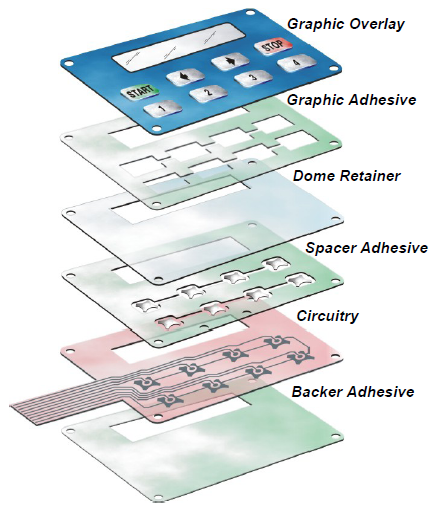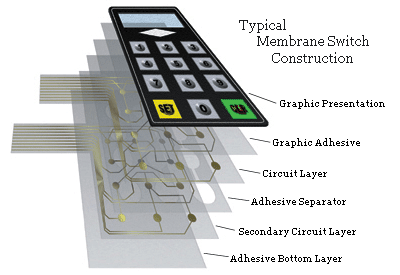Recognizing the Value of Membrane Switches in Interface
Membrane buttons are essential parts in the design of effective customer interfaces, promoting not only performance yet also improving visual charm and individual communication. As we discover the different advantages and future trends associated with Membrane modern technology, it comes to be clear that these buttons are a lot more than just components; they stand for a merging of innovation and practicality.
What Are Membrane Buttons?

The spacer layer, which has adhesive residential properties, enables the separation of the circuit layer from the overlay, making sure that the button remains in a non-activated state up until pressed. When pressure is applied to the overlay, it compresses the spacer layer, bridging the void and finishing the circuit in the underlying layer. This design not just lowers the physical room needed for typical mechanical switches but also enhances the toughness of the device, as Membrane buttons are generally immune to dirt, dampness, and various other environmental factors.
Frequently located in applications varying from customer electronic devices to medical devices, Membrane switches are important to contemporary technology, offering a reliable and easy to use interface that lines up with modern design requirements.
Benefits of Membrane Buttons
While many switch technologies exist, Membrane Switches deal distinctive benefits that make them particularly preferable in different applications. One of the main benefits of Membrane switches is their portable design, which permits space-saving executions in gadgets where realty is limited. Their slim profile not just improves aesthetic allure however likewise promotes lightweight construction.
An additional substantial advantage is their resistance to ecological aspects. Membrane switches are generally sealed versus moisture, dust, and contaminants, making them perfect for use in demanding atmospheres, such as medical gadgets and industrial equipment. This resilience prolongs the lifespan of the button, decreasing maintenance costs and enhancing dependability.
Moreover, Membrane switches can be tailored to satisfy details layout needs, including one-of-a-kind graphics and shades that improve user communication. Their responsive comments choices can additionally be customized to offer an enjoyable user experience. Furthermore, Membrane buttons are economical, especially in high-volume applications, as they can be produced successfully.
Applications in Different Industries

In the consumer electronics sector, Membrane switches prevail in devices such as microwaves, washing machines, and remote controls. Their tactile feedback and visual options improve individual experience while providing a smooth, modern-day look. Additionally, vehicle producers utilize Membrane buttons in control panel controls and infotainment systems, where room is limited, and customer engagement is critical.
In addition, the commercial sector leverages Membrane buttons in control panels for machinery and equipment, enabling instinctive procedure in frequently rough settings. Their resistance to chemicals and dampness ensures durability and dependability in these applications. Overall, the adaptability of Membrane Switches adds significantly to their widespread usage, making them crucial in various technical domains.
Style Factors To Consider for Membrane Buttons

When creating Membrane buttons, numerous crucial factors to consider must be considered to guarantee ideal performance and individual experience. First of all, the choice of materials is critical; choosing resilient, high-quality substratums can enhance the button's longevity and resistance to ecological variables such as wetness and temperature level fluctuations.
Second of all, the style of the graphic overlay need to focus on clearness and convenience of usage. Symbols and message should be understandable, and the design needs to promote intuitive communication (membrane switches). In addition, responsive comments is vital; incorporating a tactile dome or various other mechanisms can boost the user experience by supplying physical confirmation of activation
One more crucial element is the button's electrical performance. Designers must ensure that the conductive traces are effectively made to lessen resistance and prevent signal interference. This entails assessing the required actuation pressure and making sure compatibility with the digital elements they will user interface with.

Future Patterns in Membrane Modern Technology
As technology proceeds to breakthrough, Membrane switches are poised to advance significantly, driven by technologies in products and making strategies. One emerging pattern is the consolidation of sophisticated products, such as flexible substratums and conductive inks, which enhance durability and minimize the overall weight of Membrane buttons. These products not only enhance the responsive reaction but additionally permit the layout of buttons that can withstand harsher ecological problems.
Additionally, the integration of touch-sensitive modern technologies is description changing conventional Membrane Switches into more interactive customer interfaces. Capacitive touch sensing units installed within Membrane button panels can offer a much more responsive and instinctive user experience, lining up with the growing need for streamlined, modern-day layouts in consumer electronics.
Additionally, improvements in printing techniques, such as digital and 3D printing, enable rapid prototyping and customization of Membrane buttons. This adaptability allows producers to react quicker to market needs and consumer choices.
Finally, sustainability is coming to be a substantial emphasis, with manufacturers checking out eco-friendly materials and procedures. As these fads unravel, the future of Membrane innovation assures improved functionality, aesthetic charm, and ecological duty, solidifying their duty in advanced individual interfaces throughout numerous industries.
Final Thought
To conclude, Membrane Switches stand for a vital component in the layout of customer interfaces, combining functionality with aesthetic flexibility. Their advantages, including sturdiness and resistance to environmental factors, make them my blog appropriate for diverse applications across various sectors. Additionally, thoughtful style factors to consider improve user communication and experience. As advancements in innovation continue, the evolution of Membrane buttons is anticipated to additional improve interface, driving advancement and improving usability in a significantly intricate technical landscape.
Membrane switches are indispensable elements in the layout of effective customer interfaces, facilitating not just functionality but likewise improving visual charm and user interaction.Membrane Switches offer as an important component in various customer interfaces, helping with a smooth interaction between users and electronic devices.While numerous switch modern technologies exist, Membrane Switches deal distinctive advantages that make them specifically preferable in various applications.Moreover, Membrane buttons can be customized to fulfill specific layout needs, incorporating one-of-a-kind graphics and shades that boost individual communication.In conclusion, Membrane Switches stand for a vital find here component in the design of individual interfaces, combining capability with aesthetic flexibility.